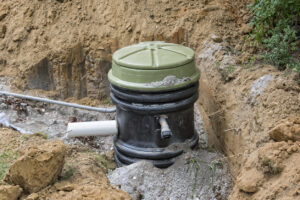
Every homeowner with a septic system understands the importance of regular septic pumping to maintain its health and efficiency. But what exactly happens during the septic pumping process? In this article, we’ll break down each step involved in septic pumping to help homeowners understand why this maintenance task is essential.
The Crucial Role of Your Septic System
A septic system functions as an underground wastewater treatment facility, commonly used in areas without access to a centralized sewer system. It includes a septic tank that separates wastewater into three layers: solids settle at the bottom, fats and oils float to the top forming a scum layer, and partially treated water remains in the middle. This effluent then flows into a drain field, where the soil provides natural filtration and further treatment.
5 Key Steps in the Septic Pumping Process
Accessing the Septic Tank
The first step is locating and opening the access lids to the septic tank. Most modern systems, especially those installed after the 1980s, have two compartments, each requiring access. Technicians carefully uncover the lids, which can sometimes be difficult due to corrosion, landscaping, or soil overgrowth.
Pumping the Tank
With access established, technicians use a high-powered vacuum hose connected to a pump truck to extract the liquids and solids. While this equipment efficiently removes the bulk of waste, heavier sludge or compacted debris may require extra effort or specialized tools.
Cleaning the Tank
After pumping, the tank is flushed with water to dislodge any remaining residue. This step helps restore the tank to a clean condition, minimizing the risk of buildup and system failure.
Inspecting the System
With the tank empty and clean, a thorough inspection is performed. Technicians check for structural issues such as cracks, root intrusions, and the condition of baffles or dividing walls. Early detection of these problems can prevent costly repairs down the line.
Closing and Securing the Tank
Once all tasks are completed, the access lids are securely closed and reburied, typically under six to twelve inches of soil. In some cases, risers are installed for easier access during future maintenance visits.
Why Septic Pumping Can’t Be Overlooked
Routine septic pumping is crucial to extending your system’s lifespan and avoiding backups or contamination. Failure to maintain the tank can result in clogs, drain field damage, environmental hazards, and expensive repairs. Regular service keeps your property safe and your system functioning properly.
Schedule Septic Pumping with T&V Backhoe & Septic Services Today
T&V Backhoe & Septic Services, based in Collinsville, OK, is your trusted local partner for professional septic pumping. Our experienced technicians ensure thorough and efficient service, protecting both your septic system and your property. Call us at (918) 855-7465 or fill out our online form. We proudly serve Collinsville and surrounding areas with reliable, top-quality septic services. Don’t wait for a messy emergency, schedule your septic maintenance today.